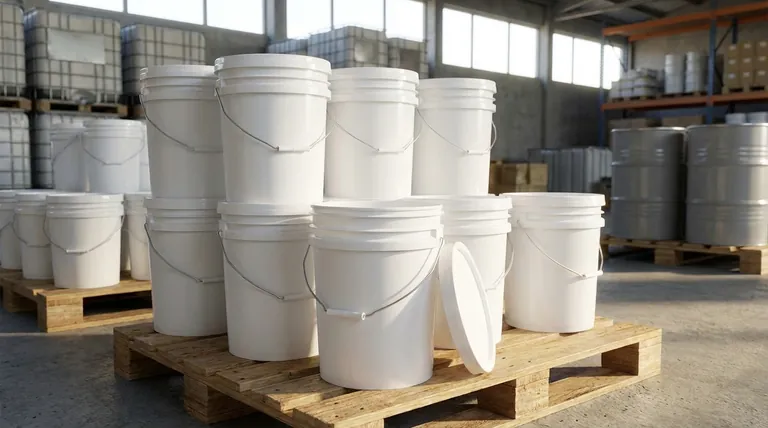In professional and industrial contexts, plastic buckets are most commonly referred to as plastic pails. While the terms are often used interchangeably in casual conversation, "pail" typically denotes a more robust, standardized container designed for specific storage and transport applications, from food and paint to industrial chemicals.
The distinction between a "bucket" and a "pail" is less about the object itself and more about its intended purpose. Understanding this nuance is the key to selecting a container that is not only functional but also safe and appropriate for your materials.

"Bucket" vs. "Pail": Decoding the Terminology
The term you use often depends on the environment. A request for a "bucket" on a construction site might get you a simple container for mixing water, while a request for a "pail" implies you need a specific, often lidded, container for materials like paint or sealant.
The Everyday "Bucket"
A plastic bucket is the general-purpose term. It describes a simple, open-top cylindrical container with a handle, typically used for carrying liquids like water or for general cleaning tasks. Its specifications are usually not critical.
The Industrial "Pail"
A plastic pail suggests a higher-grade container built for performance. These are designed to reliably store and transport specific substances. They often have reinforced structures and are made from specific types of plastic to ensure compatibility with their contents.
Key Features of a Pail
Pails are defined by their features. They almost always include a strong wire or plastic handle (a bail) and are designed to accommodate a lid. These lids are often gasketed to create an airtight and watertight seal, which is critical for paints, chemicals, and food products.
Understanding Pail Specifications and Uses
The true value of a pail lies in its material and design, which dictates its application. A pail is not just a container; it's a piece of technical equipment.
The Critical Role of Plastic Type
Pails are made from various plastics, most commonly High-Density Polyethylene (HDPE). This material is known for its strength, impact resistance, and chemical resistance. The specific type of plastic determines whether the pail is safe for its intended contents.
Food-Grade vs. Utility-Grade
A crucial distinction is between food-grade and utility-grade pails. Pails intended for storing food are made from virgin, FDA-approved plastics to prevent chemical leaching and ensure safety. Utility pails may be made from recycled materials not safe for food contact.
Common Industrial Applications
The term "pail" is standard in industries that handle a wide range of materials. This includes storing and transporting paints and coatings, construction materials like grout or thin-set, janitorial chemicals, and even hazardous materials, which require UN-rated pails.
The Trade-off: General Use vs. Specific Duty
Choosing between a generic bucket and a specified pail comes down to a trade-off between cost and safety. The risk associated with the contents dictates the required quality of the container.
When a "Bucket" Is Enough
For non-critical, low-risk tasks like washing a car, gardening, or carrying tools, an inexpensive, general-purpose bucket is perfectly adequate. The primary concerns are simply volume and durability for the task at hand.
When You Must Use a "Pail"
When storing or transporting materials that are sensitive, valuable, or hazardous, a specified pail is essential. Using a cheap bucket for chemicals or food can lead to spoilage, dangerous spills, or contamination. The higher cost of a proper pail is an investment in safety and reliability.
Making the Right Choice for Your Goal
To select the correct container, always start with your primary application.
- If your primary focus is household chores or general utility: A simple "plastic bucket" from any hardware store will meet your needs.
- If your primary focus is storing food or ingredients: You must source a container explicitly labeled as a "food-grade plastic pail."
- If your primary focus is commercial or industrial work: Use the term "pail" and be prepared to specify the volume, lid type, and material requirements for your substance.
Ultimately, choosing the right container is about matching its specifications to the demands of the job.
Summary Table:
| Feature | Plastic Bucket | Plastic Pail |
|---|---|---|
| Primary Use | General-purpose tasks (e.g., cleaning) | Industrial storage & transport (e.g., chemicals, food) |
| Material | Often general-purpose plastic | Typically HDPE, food-grade or chemical-resistant |
| Lid & Seal | May not include a lid; no specific seal | Often includes a gasketed, airtight lid |
| Common Applications | Household chores, gardening | Paints, chemicals, food ingredients, construction materials |
Need reliable, high-performance plastic pails for your business? HONESTBEE supplies commercial apiaries and beekeeping equipment distributors with durable, food-grade, and industrial-grade plastic pails designed for safe storage and transport. Ensure your materials are protected with the right container. Contact our wholesale experts today to discuss your specific pail requirements!
Visual Guide

Related Products
- Food Grade Plastic Honey Bucket Pail for Beekeeping
- Classic Drum Shaped Glass Honey Jar with Airtight Lid
- Hexagonal Glass Honey Jars with Metal Lug Caps Elegant Versatile Packaging
- Inverted Squeezable Honey Jar with No Drip Flip Top Cap for Easy Pouring
- Stainless Steel Pail Perch Bucket Bench
People Also Ask
- How heavy is a 5 gallon bucket of honey? A Beekeeper's Guide to Handling & Measuring
- Can we store honey in stainless steel container? A Guide to Safe, Bulk Honey Storage
- Can you store honey in a plastic bucket? Yes, with the right food-grade HDPE.
- How long can you store honey in a 5 gallon bucket? Preserve Quality & Safety for Decades
- What are the benefits of honey pouches? A Guide to Cost-Effective & Convenient Packaging



















